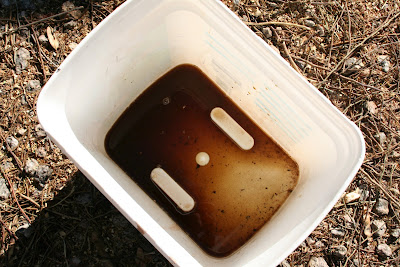 |
| January 2011 |
|
As you can see from the pictures above, the garden has made a lot of progress in the past month. (
December Garden Economics update) Lettuce, chard, radishes, beets, peas, and others are all just barely starting to produce. The past month has been great for gardening. We have had good temperatures which makes for great growth. There were three days of freezing temperatures that did slow some of the growth but nothing too drastic. The freezing temperature did kill off my chili peppers however, which is a major setback. Our dry conditions changed to wet mid-December so we haven't had to do any supplemental watering for several weeks. In two rainfall events we have totaled over 1.5 inches of rain. I'm hopeful the wet conditions will continue. As for the weather forecast it looks like we will have continued great growing temperatures and maybe some rain. But we'll see.
Here is what was produced this month:
Phoenix College garden
Easter egg radishes 26, 18 oz, $2.15, 90 calories
Cilantro about 4 bunches, 7 oz, $1.96, 49 calories
Lettuce 12 oz, $3.98, 85 calories
Chard 14 oz, $4.36, 77 calories
Shell peas 2 oz, $0.62, 24 calories
Time spent gardening: 1.75 hours
Calories burned: 278
Expenses: trellis for peas $5
$ Totals: $13.07-$5.00=$8.07
Calorie totals: 325-278=47
Home Garden
Chili peppers 8 oz, $1.50, 95 calories
Chives 10 oz, $9.45, 50 calories
Chard 8 oz, $2.49, 44 calories
Radishes 6, 4 oz, $0.50, 20 calories
Shell peas 3 oz, $0.94, 36 calories
Green onions 7 oz, $0.86, 35 calories
Time spent gardening: 2.0 hours
Expenses: $0 (already have trellises in place, made from free materials)
Calories burned: 318
$ Totals: 15.74
Calorie totals: 280-318=-38
Season totals:
College garden
$ Totals: -$56.52+$8.07=-$48.45
Hours worked: 5.75+1.75=7.5
Calorie totals:-1540+47=-1493
Home Garden
$ Totals: -$49.66+$15.74=-$40.38
Hours worked: 9.5
Calorie totals:-2049-38=-2087
So we are still in the hole both dollar and calorie wise. I expect we will catch-up dollar wise within the next month or so but we'll see. I am not sure we will catch-up calorie wise considering we are not growing calorie dense produce such as corn or potatoes. Already I am seeing ways of improving my plantings next year. For example, slower growing crops such as broccoli can be inter-seeded with fast growing plants such as radishes. Smaller crops such as green onions can be inter-seeded with larger crops. Dense plantings make the most sense, I will continue with square foot style planting but also intersperse certain plants that have different space requirements. I also need to figure out cheaper ways of pest control, and possibly do some more seed saving. All of these things would save a lot of money up front and improve productivity. I will post the next update in February.























